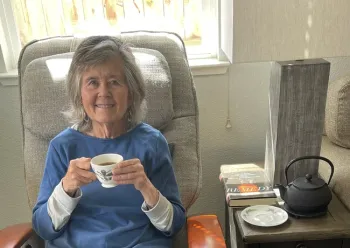
Entire cultures have developed around teas. The British have their afternoon teas, the Japanese the tea ceremony, in India it is a symbol of hospitality, and Russia has its samovar to heat water for tea. There are also myriad designs and versions of tea pots and cups.
History of Tea
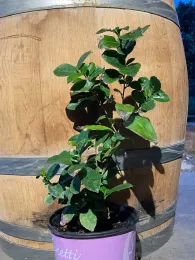
In the 1700s American colonists drank tea, just like the British. Every American school child learns about the Boston Tea Party of 1773, which was in response to a tax placed on tea by the British. As a result of the despised tax, coffee replaced tea as the number one drink in the Colonies. Today, bottled water, coffee, soft drinks, and alcohol are more popular than tea in the USA. However, worldwide, after water, tea is the most popular beverage.
I have always associated growing tea with countries that have cooler, wetter climates, and acidic soils including China, Japan, and India. However, I recently learned there are areas in eastern and northwestern USA where tea is grown. And some people here in California's Central Valley are growing tea also!
Caffeinated Teas
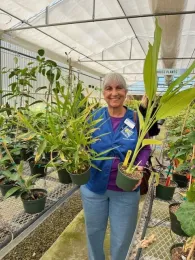
- White – plucked (harvested by hand) and withered (dried gently by air to remove water content)
- Green – plucked and fixed (exposed to heat)
- Black – plucked, withered, oxidized (dried and darkened via roasting or steaming)
- Oolong – plucked, withered, shredded and oxidized two times
You can grow C. sinesis using similar methods as C. japonica. Use a pot with an acidic potting mix (for azaleas or camellias). Keep it protected with some shade (particularly during our hot valley summers), providing it with adequate moisture. It can withstand short periods of freezing temperatures.
Herbal Teas
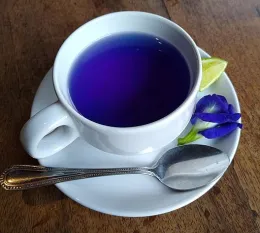
To grow herbal teas indoors you need good drainage, bright light window exposure or a grow light. If growing outside, many annual and perennial plants do well in our area. They will grow in sun or shade in well-draining soil, with different amounts of water, depending on the variety. To grow in containers, use good potting mix, with regular watering, and shade during hot summer days (may need additional watering when temperatures are 90°F+).
Some possible herbal tea plants that will grow in our climate you may want to try out:
- Butterfly Pea Flower – This tea made from dried flowers does not have much of a flavor but is enjoyed because its color is actually blue! A tropical, short-lived climbing perennial, it does well in full sun with regular watering. Plant in spring, harvest blossoms in summer. A fun fact: add lemon to the blue tea and watch it turn purple!
- Chamomile (Matricaria recutita) – Use German chamomile flowers. Can grow from seed or seedling in the spring in full sun, moderate water. Grows one foot tall to several feet wide. Harvest flowers in summer or fall.
- Jamaica or Hibiscus (Jamaica sabdariffa) – This fruity, floral tea is from fresh or dried calyx (flower sepals/enclosure). Plant seeds in late spring, it grows to 1.5 feet tall in full sun.
- Lemon Balm (Melissa officinalis) – A light lemon scent from fresh or dried leaves. A sprawling plant, it grows 2-3 feet tall in full sun or partial shade, requires regular water. This aggressive plant is best grown in pots.
- Turmeric (Curcuma longa) – This tea comes from chopped, ground, or sliced turmeric root that has been peeled. It has a golden, earthy color and flavor. It can be started indoors from purchased rhizomes (underground horizontal stems) and moved outdoors once leaves develop.
Harvesting
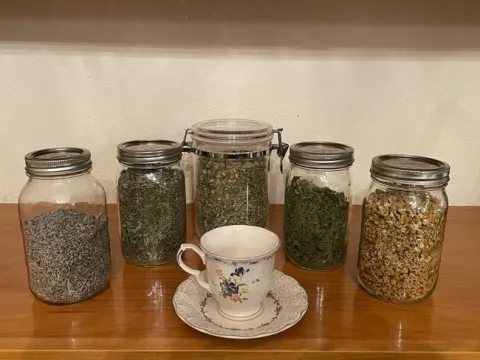
Drinking Tea
Not all teas are equal. The perfect temperature of water, and length of time to steep teas varies, depending on the tea. There is always so much to learn and enjoy about this beloved beverage.
I hear the tea kettle on the stove whistling! I am going to grab my tea mug, steep my favorite tea (Darjeeling, a black tea from India), and cozy up on the sofa with my book!
Resources
- Camellia sinesis, North Carolina State University Extension –https://plants.ces.ncsu.edu/plants/camellia-sinensis/#:~text=Smaller%20young%20leaves%20and%20leaf,the%20buds%20for%20white%20tea
- History and Health Claims of Tea, Cambridge University - https://cam.ac.uk/research/discussion/just-your-cup-of-tea-the-history-and-health-claims-of-the-nations-favourite-brew
- History of Tea, Youtube Ted Talks – https://youtu.be/LaLvVc1sS20?si+dwxBVYl4S-RapDcw
- Where the US Grows Tea – https://www.killgreen.io/main/us-grown-tea
Acknowledgments
With a special thank you to Anne Schellman, UC Cooperative Extension Master Gardener Coordinator, Stanislaus County for her valuable information based on a talk she created for the program.
Denise Godbout-Avant has been a UC Cooperative Extension Master Garden in Stanislaus County since 2020.

